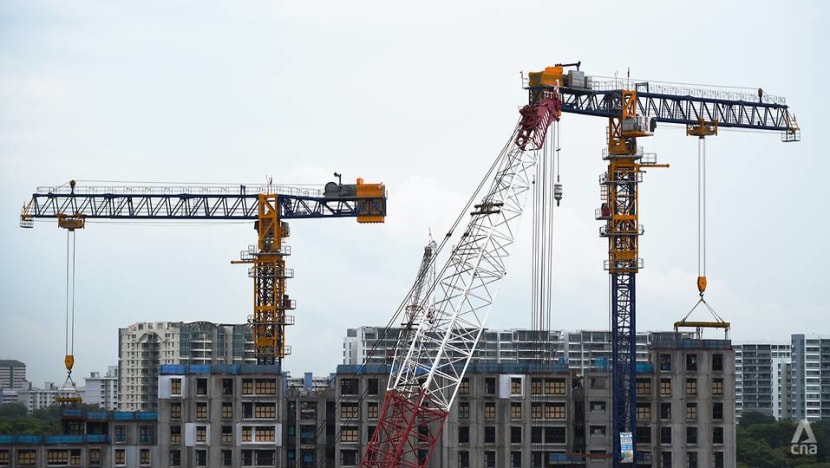More construction firms going bust after pandemic, say liquidators
The sector is still reeling from the aftermath of COVID-19 and a slump in overseas investments, on top of dealing with higher costs.

Construction cranes seen at a construction site in Singapore on May 18, 2020. (File Photo: Calvin Oh)

This audio is generated by an AI tool.
SINGAPORE: Liquidators are seeing more construction companies going under, with numbers higher than pre-pandemic levels.
Insiders said that the sector is still reeling from the aftermath of COVID-19 and a slump in overseas investments, on top of dealing with higher costs.
Construction engineering company TA Corporation, which for years profited from building freehold condominium projects, is one such victim of the spillover from the pandemic years.
It closed its subsidiary Tiong Aik Construction last July, citing inability to pay debts.
A high interest rate environment, coupled with labour and material costs rising by more than 35 per cent, also forced the firm to sell the subsidiary's office space at a loss.
“The burn rate for our company was very high for our construction arm. We're talking about S$2 million (US$1.47 million) to S$3 million a month,” said the firm’s group CEO Neo Tiam Boon.
“By cutting off this borrowing, it allows us to go on very low operating costs. So, this is the direction we took.”
The office at New World Centre was sold at S$43 million, below the market value of S$51.06 million.
With Tiong Aik Construction’s closure, the company also had to retrench about 180 staff and 600 workers.
“It was a very, very difficult decision, especially since this business started from my dad and it had been going on for the last 45 years. The family put in tens of millions of dollars personally to try and rescue the business but there was only so much we could do,” said Mr Neo.
“The COVID years were the drag. Most, if not all, construction companies suffered (similar) fate. Whenever we see each other, our first question is: ‘how much have you lost?’”
HIT BY DELAYED PANDEMIC WOES
Liquidators CNA spoke to said that the effect of delays due to the pandemic are now being felt as affected projects enter completion phase and disputes over delays and costs start to surface.
“Construction companies have been buoyed over the last few years by COVID relief measures and significant government projects in the post-pandemic era. But the reality is starting to sink in,” said lawyer Danny Quah.
“Drastic changes to global supply chains, upward pressure on costs, the severe tightening of foreign worker quotas, the strong Singapore dollar which is causing loss of competitiveness in exports – these are but some of the factors creating the perfect storm for construction companies to undergo insolvency or restructuring proceedings.”
On top of the challenging environment, construction firms also face having to meet project completion deadlines or be served expensive lawsuits.
HIGH NUMBER OF DEFAULT LOANS
Mr Quah, who is director of civil and commercial litigation and arbitration at law firm CHP Law, said he expects to see an increase in the number of liquidations of construction firms.
The sector had the greatest number of default loans overall last year at 6.81 per cent, compared with an average of 1.72 per cent, according to the Monetary Authority of Singapore (MAS).
The outlook is especially bleak for general contractors, experts said.
“With the residential market cooling down, we are likely to see less new residential development,” said Mr Tan Wei Cheong, a partner with consultancy firm Deloitte Singapore.
“Construction companies that are general builders may start to see less demand for such services. This will affect them moving forward until the property market improves again.”
The latest national business survey by the Singapore Business Federation found that a higher proportion of construction businesses indicated they are facing some form of inability to finance their operation. The report released in January showed that 10 per cent of the sector is facing a severe credit crunch, compared with 3 per cent in 2022.
In the current environment, industry players are more careful when it comes to taking on new projects.
“Businesses are more cautious right now. We don't see people making big decisions in terms of investments or financing because they don't know where things are moving. A lot of people are observing and taking a more defensive position,” said Mr Tan.
PUBLIC PROJECTS PROP UP SECTOR
Still, bright spots remain. Public projects propped up growth in the construction industry in the first quarter this year, even as private sector construction output fell.
The public sector is expected to contribute about 55 per cent of total construction demand this year, including new Build-To-Order (BTO) flats, phase two of the Cross Island MRT Line, and airport and port developments.
“Every company has a different appetite for risk,” said Mr Kenneth Loo, executive director of Straits Construction Singapore.
“At the end of the day, when you tender for a job, you have to evaluate your own resources and your own position on how to move forward. If you take a higher risk, and if your resources are insufficient, that will be very challenging.”
Meanwhile, TA Corporation’s Mr Neo said the firm will concentrate on other areas such as high value bungalows, and does not foresee returning to high rise private housing construction such as condominiums in the foreseeable future.
“Personally, I will not go back to this industry again because it's no longer viable, and competition is very steep,” he said.
However, even with the closure of contractors such as Tiong Aik Construction, homeowners are unlikely to be heavily impacted, as developers will be able to quickly find replacements, Mr Loo said.



















